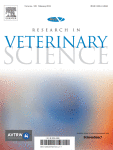Ver ítem
- xmlui.general.dspace_homeCentros e Institutos de InvestigaciónCICVyA. Centro de Investigación en Ciencias Veterinarias y AgronómicasInstituto de BiotecnologíaArtículos científicosxmlui.ArtifactBrowser.ItemViewer.trail
- Inicio
- Centros e Institutos de Investigación
- CICVyA. Centro de Investigación en Ciencias Veterinarias y Agronómicas
- Instituto de Biotecnología
- Artículos científicos
- Ver ítem
Identification of bovine tuberculosis biomarkers to detect tuberculin skin test and IFNγ release assay false negative cattle
Resumen
Bovine tuberculosis (bTB) is an important animal and zoonotic disease, which causes severe economic losses. The main focus of this study was to assess the predictive power of previously identified biomarkers of bTB in infected animals that were negative to the tuberculin skin test (TST). We studied 16 animals with bTB, in which the disease was confirmed by necropsy, and 16 healthy animals. The level of expression of ten biomarkers (CXCL9, THBS1, MMP9,
[ver mas...]
Bovine tuberculosis (bTB) is an important animal and zoonotic disease, which causes severe economic losses. The main focus of this study was to assess the predictive power of previously identified biomarkers of bTB in infected animals that were negative to the tuberculin skin test (TST). We studied 16 animals with bTB, in which the disease was confirmed by necropsy, and 16 healthy animals. The level of expression of ten biomarkers (CXCL9, THBS1, MMP9, IL-22, CXCL10, IFNγ, IL-17, FYVE, CD14, IL-1R) was evaluated by RT-qPCR upon stimulation or not of peripheral blood mononuclear cells with PPDb (purified protein derivative of bovine tuberculin). In this assay, CXCL9, THBS1, MMP9, IL-22 and IFNγ changed their expression level depending on the bTB status. In addition, we evaluated different biomarker candidates simultaneously to infer the animal condition. By performing an analysis with classification trees, we found that the sturdiest combination was IL-22, IFNγ and IL-1R. On the other hand, CXCL10, IFNγ and IL-22's expression distinguished between bTB positive animals that were negative to TST (TST false negative animals) and the bTB negative groups. Thus, these biomarkers are promising candidates to be tested as an ancillary diagnostic assay. In addition, the expression of CXCL10 and IL-22 exhibited also significant differences between the bTB positive animals that were undetectable by IFNγ release assay (IGRA) and TST tests (TST and IGRA false negative animals) and the bTB negative groups. Therefore, CXCL10 and IL-22 constitute candidate biomarkers that could complement the two most widely used diagnostic tests.
[Cerrar]

Autor
Fuente
Research in veterinary science 122 : 7-14. (February 2019)
Fecha
2019-02
Editorial
Elsevier
ISSN
0034-5288
Formato
pdf
Tipo de documento
artículo
Palabras Claves
Derechos de acceso
Embargado
 Excepto donde se diga explicitamente, este item se publica bajo la siguiente descripción: Creative Commons Attribution-NonCommercial-ShareAlike 2.5 Unported (CC BY-NC-SA 2.5)
Excepto donde se diga explicitamente, este item se publica bajo la siguiente descripción: Creative Commons Attribution-NonCommercial-ShareAlike 2.5 Unported (CC BY-NC-SA 2.5)

